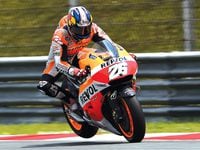One good way to judge your own level of riding competence is by asking yourself this question: Do you think about the controls, or do you think with the controls? There is a difference. Thinking about the controls is what you did while learning to ride; the lion’s share of your attention went directly to operating the levers, handlebars, and twistgrip. Thinking with the controls is knowing what you want the bike to do and then using the controls to produce that result.
Case in point: How would you like the bike to feel when leaned over in a corner? Most riders agree they’d like the bike to feel stable. With that in mind, look at the bike and ask what it requires in terms of control inputs to achieve that state of equilibrium.
Conventional wisdom tells us that the purpose of suspension is to keep the tires on the ground. Tires kept in continuous contact with the roadway provide us with optimum traction, and this requires only suspension that is reasonably adequate and able to handle the road surface. But there is another very practical way of looking at suspension that fits in with our desire for stability.
An ideal suspension would respond to even the slightest pavement variation. All the peaks and voids caused by bumps, ripples, seams, and such would be absorbed and neutralized. The bulk of the bike’s mass—including the rider—would remain suspended and motionless on the vertical plane with only the slightest changes in pitch angle, if any change at all.
There are springs in the fork and rear shock(s), and no reasonably adjusted suspension will produce the above result if either spring is extended or compressed too much. The suspension must remain in the middle of the available travel, with the compression and rebound damping both adjusted accordingly, to approach that ideal state.
Think of the bike and rider in terms of a horse and jockey. Imagine that the horse is the road moving up and down. The jockey’s body is the bike; his legs are the suspension. The jockey remains as motionless as possible on the vertical and pitch axes. His legs isolate him from the horse’s stride variations. In the bike’s case, the suspension—if approaching our ideal—would comply with any pavement imperfections well enough to completely isolate the bike and rider. Theoretically, a glass of water set on the tank would remain there without sloshing or spilling. (In case you’re wondering, even the most sophisticated electronic suspension systems cannot do this—yet.)
Back to the point: Off the gas and entering into a turn, a majority of the bike’s weight transfers forward, compressing the front suspension while trying to top out the rear shock at the same time. Ideal stability is not possible under these circumstances, when the suspension is so far out of its compliant, mid-stroke range.
As we come back into the throttle, the fork begins to unload and quickly return to its mid-stroke range. Weight transfer rearward creates a similar result at the back end, returning the shock to its most-effective portion of travel. This move toward optimum suspension compliance is, at this point, the result of the rider rolling on the throttle and nothing else. Increasing the stability begins with rolling on the throttle.
Each time you roll onto the throttle with the goal of achieving or increasing stability, you are thinking with the throttle, not about it. There is a clear, well-defined purpose for the action, and it produces a result you can immediately feel. In addition to stability, this also acts to optimize traction and improve the bike’s ability to hold its line. Once any rider begins to understand and apply this concept of thinking with the controls, he or she has reached an important riding-skill plateau.
Keith Code, credited as the father of modern track schools, founded his California Superbike School in 1980 and currently operates programs in 11 countries and on six continents. His "A Twist of the Wrist" series of books and DVDs are thought by many to be the bible of cornering.











/cloudfront-us-east-1.images.arcpublishing.com/octane/2WF3SCE3NFBQXLDNJM7KMXA45E.jpg)
/cloudfront-us-east-1.images.arcpublishing.com/octane/G4MG6OUCJNBSHIS2MVVOTPX65E.jpg)
/cloudfront-us-east-1.images.arcpublishing.com/octane/IIGGWFOTOJGB7DB6DGBXCCMTDY.jpg)
/cloudfront-us-east-1.images.arcpublishing.com/octane/QSTCM6AVEZA5JJBUXNIQ3DSOF4.jpg)
/cloudfront-us-east-1.images.arcpublishing.com/octane/U4I7G625B5DMLF2DVIJDFZVV6M.jpg)
/cloudfront-us-east-1.images.arcpublishing.com/octane/B6XD6LS6IVCQPIU6HXDJSM3FHY.jpg)
/cloudfront-us-east-1.images.arcpublishing.com/octane/ICL63FEDDRDTTMINYICCEYGMDA.jpg)
/cloudfront-us-east-1.images.arcpublishing.com/octane/FCGZHQXRBZFLBAPC5SDIQLVF4I.jpg)
/cloudfront-us-east-1.images.arcpublishing.com/octane/WNOB6LDOIFFHJKPSVIWDYUGOPM.jpg)

/cloudfront-us-east-1.images.arcpublishing.com/octane/X33NU3E525ECRHXLNUJN2FTRKI.jpg)
/cloudfront-us-east-1.images.arcpublishing.com/octane/6KKT5NNL2JAVBOXMZYS5ZO76YA.jpg)
/cloudfront-us-east-1.images.arcpublishing.com/octane/J5RKG5O455GMPGQRF2OG6LRT7A.jpg)
/cloudfront-us-east-1.images.arcpublishing.com/octane/GX2CIZKQVRH2TATDM26KFG2DAE.jpg)
/cloudfront-us-east-1.images.arcpublishing.com/octane/ZWIDYSAKQZHD5BHREMQILXJCGM.jpg)
/cloudfront-us-east-1.images.arcpublishing.com/octane/CYUHJZCTSJCH3MRAQEIKXK7SCQ.jpg)
/cloudfront-us-east-1.images.arcpublishing.com/octane/LKOFINY56FCXJCANJ5M7ZDQUBY.jpg)
/cloudfront-us-east-1.images.arcpublishing.com/octane/4NBPDACMWJH63JQYJVK3QRBDZI.jpg)
/cloudfront-us-east-1.images.arcpublishing.com/octane/KKHQHRR3FJGX7H2IPU6RALMWG4.jpg)

/cloudfront-us-east-1.images.arcpublishing.com/octane/5IOFS5JAE5FOXMNA23ZRAVVYUU.jpg)
/cloudfront-us-east-1.images.arcpublishing.com/octane/CGXQ3O2VVJF7PGTYR3QICTLDLM.jpg)

/cloudfront-us-east-1.images.arcpublishing.com/octane/OQVCJOABCFC5NBEF2KIGRCV3XA.jpg)